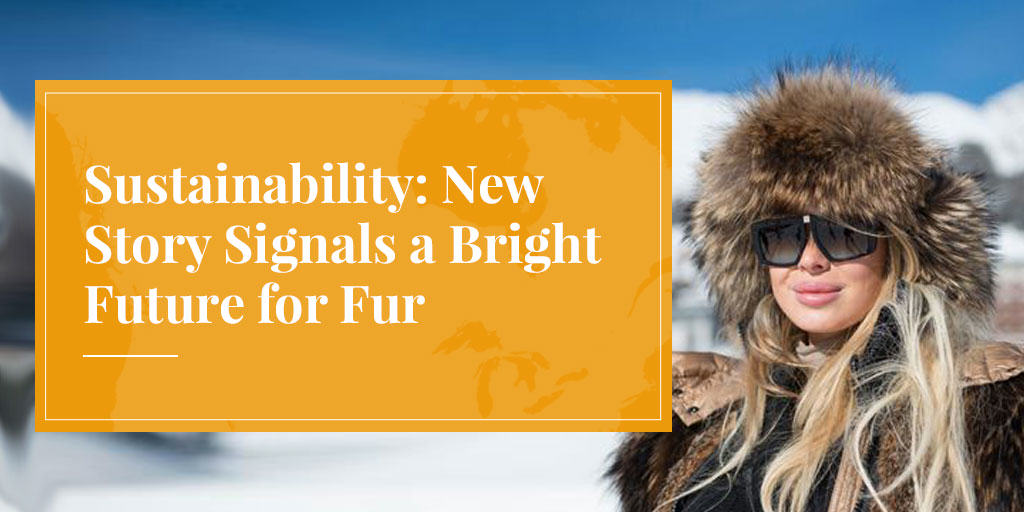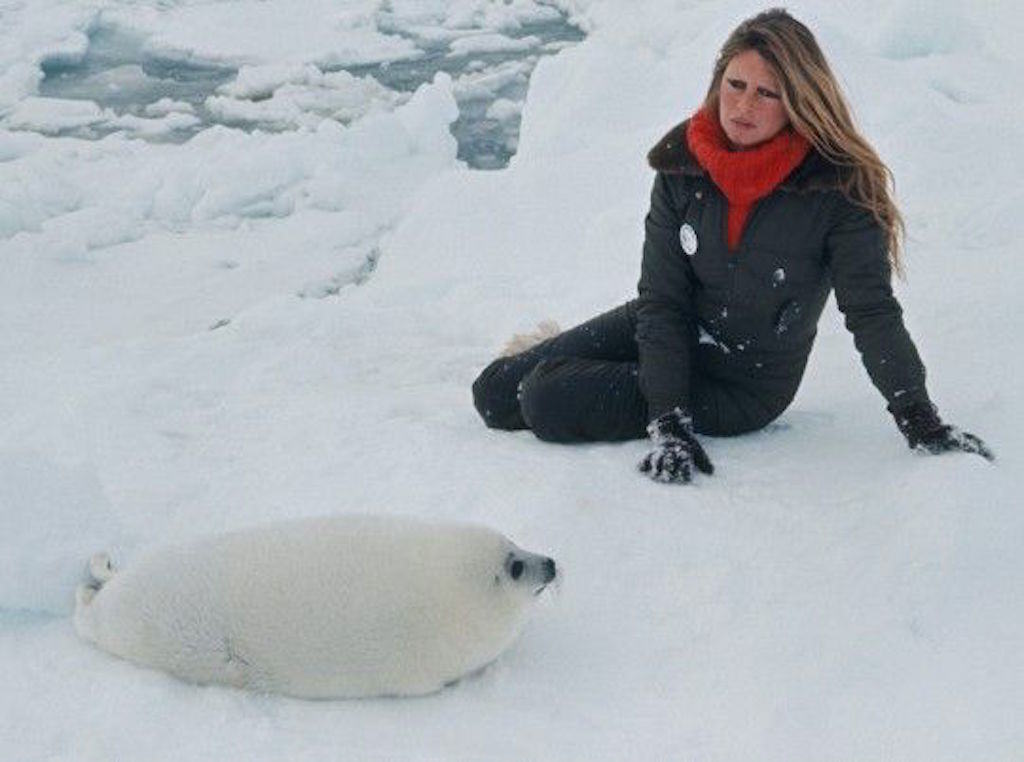
The growing media and public interest in sustainability – especially among young people – provides an extraordinary opportunity for the fur trade.
To understand why, think about the vital role that stories play in our lives. Because story-time is much more than those precious minutes we spend with young children at the end of a hectic day. Stories define what it means to be human and are central to our success as a species. “Really?” you ask. Bear with me a moment and we’ll see why – and what this means for the future of fur.
Stories Are Our Social Glue
What’s special about humans is that we work together in large groups. Ants and bees also work in large groups, of course, but only in rigidly programmed patterns of behaviour. Humans are the only animals that cooperate with strangers in ways that can evolve to meet new challenges. And stories are the social glue that allows us to do this. They tell us who we are and what we are trying to achieve.
For much of our history, these stories were expressed in myths or religions. In a more secular age, societal identity and goals are often articulated in new types of stories: Nationalism, Marxism, Liberalism – and, more recently, environmentalism and animal rights.
For much of the 20th century, Western society was driven by a story about science and technology generating prosperity and continual growth. During this period, the story of fur was about warmth, beauty and status. Think glamorous movie stars wrapped in luxurious mink.
The publication of Rachel Carson’s Silent Spring, in 1962, sounded the alarm that unchecked growth could threaten our very survival as a species. Carson’s landmark book launched the modern environmental movement and signalled the emergence of a new story: Earth could no longer be seen as a treasure chest to be looted, but rather was a garden to be protected as if our lives depended on it … because they do!
With the environmental movement came concern that wildlife populations were being depleted. But while biologists know that the destruction of natural habitat is the most serious threat to wildlife, a good story needs clearly identified good guys and bad guys. Hunters – once admired in American frontier mythology – were clearly the bad guys in this new scenario, portrayed as violent and cruel.
Protesters were the good guys, the valiant protectors of Mother Earth. Through the 1960s and ’70s, Greenpeace and dozens of other new organizations emerged to protest the commercial hunting of seals, spotted cats, and other charismatic species – garnering international media attention while generating millions of dollars for a lucrative new protest industry.
The good news is that this media attention helped to rally financial and political resources to address some real conservation and animal-welfare concerns. By the early 1970s, seal hunters received training and quotas were introduced to prevent overharvesting. The Convention on International Trade in Endangered Species (CITES), in 1975, ensured that leopards and other vulnerable wildlife populations were not threatened by trade. And by the late 1970s, the world’s first science-based humane trap-research program was established, with support from the Canadian Federation of Humane Societies, the Canadian government, and the fur industry.
But these important achievements did not end the protests. As documented in my book Second Nature: The Animal-Rights Controversy (CBC, 1985), the campaigns against seal hunting actually intensified, especially after Greenpeace brought Brigitte Bardot to the ice in 1977. Greenpeace’s Bob Hunter observed that this juxtaposition of sex and violence made the seal hunt an irresistible media story. Protests against fur trapping also gained momentum, at the same time as fur prices and sales were hitting record levels through the 1970s and ’80s.

The persistence of anti-fur campaigning after the real conservation and animal welfare issues were addressed is explained, in part, by interests. With hundreds of protest groups – and thousands of professional activists – raking in millions of dollars from well-meaning supporters, there was little incentive to say, “Mission accomplished, let’s go home.”
Equally important, however, was the emergence of a new story: animal rights. With the publication of Australian philosopher Peter Singer’s 1975 book Animal Liberation: A New Ethics for Our Treatment of Animals, this new story made a radical break with traditional conservation and animal welfare objectives. It questioned the right of humans to use animals at all. This new story is summarized in PETA’s mission statement: “Animals are not ours to eat, wear, use for entertainment, or abuse in any other way.”
This new animal-rights story allowed activists to completely ignore the fur trade’s achievements. Sure we now have research, government regulations, and industry codes of practice. But what does any of this matter if, as Peter Singer, Tom Regan, Bernard Rollin, and other animal rights philosophers argued, it is simply wrong to kill animals for human use?
The use of animals is morally indefensible, these philosophers argued, because we have options. So while the lion must kill to live, humans can thrive as vegetarians. Similarly, there is no justification for using fur (or wool, leather, or other animal products) because we now have synthetic materials to keep us warm. And this is where the story gets interesting. Or rather: the stories. Because another story is now emerging – environmental sustainability – and this new narrative has very different things to say about the ethics of using fur.
Landmark Document: Our Common Future
The concept of sustainable development was coined by the report of the United Nations World Commission on Environment and Development (WCED) – the Brundtland Commission – published in book form as Our Common Future, in 1987. This landmark document recognized that humans are part of nature and depend on natural resources for our survival; we cannot “leave nature alone”, as protesters demanded. The real environmental challenge is to meet “the needs of the present without compromising the ability of future generations to meet their own needs.”
In layman’s terms this means living on the “interest” that nature provides, without depleting our environmental “capital”. So, whenever possible, we should use renewable resources (plants, animals) rather than non-renewable resources (petroleum-based synthetics). And we should use these resources sustainably, i.e., no faster than nature can replenish the supply.
Thirty years after the publication of the Brundtland Commission, sustainability is finally gaining traction. Companies of all sorts are rushing to promote their products and services as sustainable. Sustainable lifestyles are the new cool. What many have not yet understood is that sustainable use is very different from the no-use doctrine promoted by anti-hunt protesters and animal rights philosophers. While fur and other animal products are morally indefensible from an animal rights perspective, they are the way to go when looked at through the lens of sustainability.
A flagrant example of this misunderstanding is the recent claim by CEO Marco Bizzarri that Gucci would stop working with fur to demonstrate their “absolute commitment to making sustainability an intrinsic part of our business.”
SEE ALSO: Fur-free Gucci policy contradicts company’s “sustainability” claims
SEE ALSO: Sustainability: Why is Gucci so confused?
Sustainability vs Animal Rights
The importance for the fur trade of the impending clash between these two powerful stories – sustainability and animal rights – should not be under-estimated. Most of the time, most people – and societies – drift along without questioning the fuzzy ideas that guide our actions. But when conflicting stories collide, we must stop and think. As sustainability crashes into animal rights, the fur trade will finally have an opportunity to tell its story.
The new International Fur Federation video comparing the sustainability of fur and synthetics is a good example of how this contradiction can be promoted. The website FurIsGreen.com is another.
A recent story in the influential British tabloid, The Sun, demonstrates the power of this clash of ideas to spark a new sort of discussion about fur. The headline stated: “Why Kim’s fake fur is worse for the environment than Kourtney’s real one.”
“For decades we’ve accepted the notion promoted by animal rights campaigners that wearing or buying real fur is ethically and morally bankrupt. … Yet recently a more complex and nuanced view has emerged, backed by experts in the fur industry, that suggests faux fur could, in fact, be worse for the environment than the real thing,” reported The Sun, citing the International Fur Federation, Fur Commission USA, and other sources.
The problem is that faux fur is made from petroleum, a non-renewable resource. Furthermore, recent research is revealing that clothing made from petrochemical synthetics leaches microfibers of plastic into the environment every time it’s washed. These microfibers do not biodegrade; they are carried into waterways, enter the food chain, and are now being found in the digestive tracts of marine life. Real fur, by contrast, is biodegradable and doesn’t cause these problems. And real fur can also be restyled and recycled, providing decades’ more use than synthetic “fast fashion” apparel.
SEE ALSO: The great fur burial: How fur biodegrades after one year
SEE ALSO: 5 great ways to recycle old fur clothing
If sustainability can provoke this sort of serious reflection in a British tabloid newspaper, it can do it anywhere. And sustainability has strong support from the scientific community; animal rights does not. Not least important, young people are particularly interested in sustainability – after all, they will be here longer! All this suggests that the sustainability story is likely to become increasingly influential.
In recent years, animal activists have worked hard to portray fur as a flagrant example of the reckless exploitation of nature: “killing innocent animals for greed and vanity.”
As a more serious understanding of environmental sustainability takes hold, we now have an opportunity to rewrite the story again – and this time fur will finally be recognized as not only warm and beautiful, but also a celebration of the marriage of human creativity with the responsible and sustainable use of nature’s bounty.
The fur story is about to become much more interesting!
***
To learn more about donating to Truth About Fur, click here.











For now, I hate the activists who want to teach us how to live. Often I have tried to argue with activists, unfortunately they were not ready, some were biased and even think that there is only life on earth that is incumbent upon man and the beast, all other living beings on earth can be used.
For me, these people have a way of thinking that I can not accept.
A person who thinks will wear fur.
This is the path we have been looking for Alan. Well done.